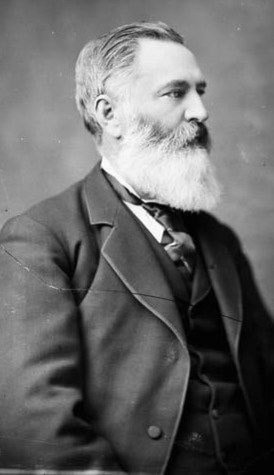One hundred thirty-fourth in an alphabetical series on West Kootenay/Boundary place names
Last week we saw that Nelson was formerly known as both Stanley and Salisbury before the name changed in October 1888 to honour BC Lt.-Gov. Hugh Nelson (1830-93). Stanley was downtown and Salisbury was what’s now the Fairview neighbourhood, though the distinction wasn’t always clear.
But there aren’t many surviving references to Stanley, suggesting it wasn’t used for very long. Ed Mannings has studied this subject, and concluded the name existed for little over a month, based on reports filed by assistant land and works commissioner Gilbert Malcolm Sproat, who came up with both Stanley and Nelson.
In 1886, Sproat referred to the “Fort Shepherd subdivision,” which he defined as “the block of country about Fort Shepherd, chiefly on the east side of the Columbia, bounded by that river, the Kootenay River, and the US boundary — a country in which the well-known 49 Creek and Salmon Creek [lie].”
In December 1887, he wrote of “a mountain called ‘Toad’ Mountain,” and on Aug. 18, 1888 mentioned “Toad Mountain Camp” and the “Toad Mountain Mines.” He also noted: “The ore being shipped is sent by a six mile trail on pack horses to the steamboat landing on Kootenay Lake, near the mouth of Cottonwood Creek.” Yet he gave no name for that steamboat landing.
On Sept. 3, 1888, Sproat filed another report entitled “Memorandum on Proposed Townsite.” According to Nelson: A Proposal for Urban Heritage Conservation, in this document Sproat “tentatively named the townsite Stanley but stated that Nelson … would be equally suitable. He felt that ‘there is wanted an easy two-syllabled name men can readily spell and with some historic or local appropriateness.’ The suggestion to call the community by the name of Salisbury was rejected by Sproat because the word had three syllables and had ‘no local or Canadian associations.’”
The name Stanley was used until Oct. 13, when Sproat’s ad in the Victoria Daily Colonist for the auction of townsite lots was changed to read Nelson.
Hugh Nelson never saw his namesake town, although Sproat tried to entice him to buy lots. Nelson was born in Inagheramore, County Atrim, Ireland, and emigrated to California in 1854. He arrived in BC four years later and co-founded the BC and Victoria Express Co. and Moodyville Sawmill Co.
In 1870, Nelson was elected to the legislative council of colonial BC and the following year became one of BC’s first MPs when the province joined confederation. He was named to the senate in 1879 and served as BC’s lieutenant-governor from 1887-92. Although there is no doubt he is Nelson’s namesake, the notion emerged that the city’s name actually honoured Lord Horatio Nelson (1758-1805), the British naval officer for whom explorer David Thompson named what are now the Selkirk mountains.
“There is a widespread belief especially among those coming from Great Britain in later years that the city was named after Lord Nelson,” Dr. E.C. Arthur wrote in the Nelson Daily News of Aug. 18, 1937. “This belief dies hard and in my opinion the naming of one of our schools Trafalgar was an important circumstance in that it tends to perpetuate this error.” (Lord Nelson was killed during the Battle of Trafalgar.) It didn’t help either that a local hotel was known for many years as the Lord Nelson (it later reverted to its previous name, the New Grand, and is now the Adventure Hotel).
Another oddity is that when James White of the Canadian Geographic Survey inquired in 1905 about how Nelson got its name, part of the reply stated: “Nelson was first called Buntonville [sic], after the man who first staked it out as a pre-emption and who had to give it up, as a government reserve was placed upon it by Mr. Sproat.”
This is probably just a mistake. Arthur Bunting did file the first pre-emption in 1887 (or claimed he did), but there’s no other sign the name Buntonville or Buntingville was ever used.
Next: Nelson City or Bogustown?
Previous installments in this series
Applegrove, Appleby, and Appledale revisited
Bakers, Birds, and Bosun Landing
Bannock City, Basin City, and Bear Lake City
Bealby Point (aka Florence Park) revisited
Boswell, Bosworth, Boulder Mill, and Broadwater
Brooklyn, Brouse, and Burnt Flat
Camborne, Cariboo City, and Carrolls Landing
Carmi, Cedar Point, Circle City, and Clark’s Camp
Carson, Carstens, and Cascade City
Christina City and Christian Valley
Cody and Champion Creek revisited
Champion Creek revisited, again
Columbia City, Columbia Gardens, and Columbia Park
Crawford Bay and Comaplix revisited
Dawson, Deadwood, and Deanshaven
English Cove and English Point
Forslund, Fosthall, and Fairview
Fort Shepherd vs. Fort Sheppard, Part 1
Fort Shepherd vs. Fort Sheppard, Part 2
Gladstone and Gerrard, revisited
Hall Siding and Healy’s Landing
Hudu Valley, Huntingtdon, and Healy’s Landing revisited
Inonoaklin Valley (aka Fire Valley)
Jersey, Johnsons Landing, and Jubilee Point
Kootenay Bay, Kraft, and Krestova
Kuskonook (and Kuskanax), Part 3
Labarthe, Lafferty, and Longbeach
Makinsons Landing and Marblehead
McDonalds Landing, McGuigan, and Meadow Creek
Meadows, Melville, and Miles’ Ferry
Mirror Lake and Molly Gibson Landing
Montgomery and Monte Carlo, Part 1
